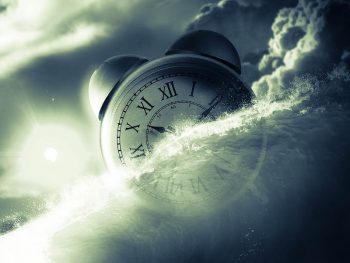May 24th, 2018
By Mateo Sol
Guest writer for Wake Up World
What is Hypnagogia?
We all know that there are two primary states of consciousness: wakefulness and sleep. But did you that there is also an in-between state? This state is called Hypnagogia, a word that derives from the Greek words “hypnos” (sleep) and “agogos” (leading), meaning the state that leads into sleep.
Have you ever had a nap and experienced a strange trance-like state in which images, colors, sounds, even dream-like stories play out in your mind? Have you ever found yourself falling asleep and seeing a kaleidoscope of colors and shapes fleet in and out of your mind … or strange things like horses turning into helicopters? These experiences are hypnagogia in action and it’s likely that you experience hypnagogia multiple times a week, or even every day before you fall asleep!
So how can this unusual limbo state contribute to our self-understanding and spiritual growth? In this article, I’ll explain how.
Types of Hypnagogia
Depending on whether you are primarily a visual (image-oriented), auditory (sound-oriented), or kinesthetic (physically-oriented) person (you can take a test here), your hypnogogic experience will vary.
Here are common ways hypnagogia is experienced:
- Images – e.g. monochromatic or colorful, static or moving, flat or three-dimensional – usually the images are fleeting but sometimes they form entire dream-like scenes
- Sounds – may be loud or quiet and involve hearing music, voices, snatches of conversation, rain, wind, white noise, repetitive words, having one’s name called, etc.
- Repetitive actions – known as the “Tetris effect,” when a person has spent a long time doing something repetitive (such as working, playing chess, exercising, reading) they may find themselves doing the same thing as they fall into the hypnagogic state
- Physical sensations – tastes, scents, textures, and sensations of coldness and heat may be experienced during hypnagogia, as well as feelings of floating, falling, leaving one’s body or having one’s body change shape
- Mental processes – at the edge of sleep thoughts begin to take a fluid and free-associative quality in which they morph and evolve in unusual, abstract, and innovative ways, uninfluenced by the ego
- Sleep paralysis – the temporary inability to move may, in some occurrences, accompany hypnagogia, however while this state may be alarming, it is harmless
It is also possible (and common) to experience multiple forms of hypnagogia. For example, you might visually enter a memory from the day that transforms before your eyes into an array of physical sensations and sounds. The combinations are limitless.
Spiritual Oneiromancy, Dali, and Dream Yoga
Throughout history, there have been many writers, artists, and philosophers who have used hypnagogia as a way of triggering new ideas, insights, and even inventions.
Artist Salvador Dali, writer Mary Shelley (author of Frankenstein), and inventor Thomas Edison are some of the most notable historical figures who have used hypnagogia to stimulate saucy new ideas. Both Dali and Edison, for example, used very similar techniques of sitting down with objects in their hands (a key for Dali and brass balls for Edison) and waking up once the object fell and hit the floor. This sudden awakening allowed them to quickly jolt out of their hypnagogic slumber and write down the thoughts and images that had been dancing through their minds.
In Tibetan Buddhism, hypnagogic states are used as a way of practicing “dream yoga.” Dream yoga is a form of spiritual practice that is based on the premise that dream-like states can be used to train the mind to enhance spiritual awareness. This self-discipline can contribute to the experience of enlightenment.
In the modern age, there’s a niche of people who refer to themselves as Oneiromancers; or individuals who use dreams as a form of divination. The word Oneiromancy comes from the Greek ‘oneiros’ (dream) and ‘manteia’ (prophecy). Such people commonly use and interpret dreams as a way of prophesying the future.
Even psychologists such as Carl Jung and Sigmund Freud have taken an intense interest in dreams and their potential meanings. Jung was notorious for his fascination with dreams and their connection with the unconscious mind since childhood.
I can’t personally vouch for the divination aspect of dreams (as in ‘oneiromancy,’ although I have had prophetic dreams). Furthermore, I believe that predicting the future is useless and a major distraction unless it is accompanied with work grounded in the present-moment. That is why my approach to dreams and hypnagogia specifically is targeted towards psychological growth. Without understanding yourself, meeting your shadow self, uncovering and dealing with old traumas and wounds, and integrating what you find, you won’t get very far. All of the dream work in the world will be just that: a bunch of fantasy.
How to Use Hypnagogia to Explore Your Unconscious Mind
“Hypnagogia is the shortest path for communication from our subconscious.” — Sirley Marques Bonham Ph.D, physicist
In the secular world, hypnagogia is often used as a way of stimulating creativity. But I propose, similar to the Tibetan Buddhists and their ‘Dream Yoga’ and Carl Jung and his technique of ‘Active Imagination,’ that hypnagogia can be used for deep psychological discovery as well.
By seeking to find patterns, interpreting the images that arise, and coming in contact with the fragmented aspects of yourself, hypnagogia is a powerful form of self-exploration, and one with the potential of uniting you with your Soul’s Wholeness and ultimate purpose.
The unconscious mind is the part of our brain that contains everything we have buried away and forgotten: memories, defense mechanisms, wounds, ancestral traumas, archetypal forces or ‘sub-personalities’ – you name it.
In the trance-like state of hypnagogia we are able to observe our unconscious mind and its contents as it begins to bubble to the surface.
If you want to learn a simple and effective way of using hypnagogia to explore your unconscious, practice the one below:
1. Set an intention – ‘Prime’ your mind and get it ready before you go to sleep or have an afternoon nap. You can do this by constantly thinking about what it is you want to explore about 20-30 minutes before you go to rest. For example, your intention might be to find out why you struggle to have self-control around certain people, what mental belief is blocking your happiness, what your Shadow wants to tell you, or anything that is to do with you as a person. I find that it helps to be very clear about my intention and summarize it into a sentence. You can even write this sentence on a piece of paper if it helps. For example, your summarized intention might be “I want to understand why I always attract the wrong partners,” “I want to discover how to strengthen my social boundaries,” “I want to find out why I feel so unhappy and lost,” etc. Meditating on your intention is also a powerful way of priming your mind beforehand.
2. Find something to record your experience – Before you enter hypnagogia, find a notebook, journal, sketch pad, or voice activated recorder (there are mobile apps for that), and place it next to your bed/sofa/chair.
3. Set a gentle alarm – It takes on average about 10 to 20 minutes to fall asleep. So take a moment to consider how long it takes you on average to fall asleep. Do you go under quickly? In this case you might like to set the alarm on your phone or clock to 10 minutes. If you take a long time to fall asleep, experiment with setting your alarm to 20 minutes. With experience, and assessment of how tired you are beforehand, you’ll be able to skillfully adjust the alarm to the perfect amount of time that you need.
4. Take a nap – Remember, your intention isn’t to fall asleep, (although if that happens, don’t worry, it can take practice!). Lie down on your bed, sofa, or whatever is comfortable, and relax. Let your body and mind drift off into a soft and hazy stupor. Completely unwind and let yourself be still.
5. Observe your mind – It is not always possible to clearly observe your mind, particularly when your consciousness is fading, which is why this step takes practice. You can use the sensation of your breath or chest rising and falling to help anchor yourself to awareness as you notice what is going on.
6. Time to record! – Bzzzz! At some point your alarm will go off. (Hopefully you set a gentle alarm, because loud obnoxious alarms can really be, well, alarming.) Once you’ve woken up, record what you have heard, seen, felt, or experienced. Do this quickly so that you don’t forget.
7. Interpretation – Reflect on what you have written, drawn or recorded. What are the first thoughts or feelings that pop into your mind? If you experience a strong physical/emotional ‘aha!’ reaction, you have found the right interpretation. Does your interpretation inspire, excite, or shock you? If so, it is probably correctly interpreted. According to Jungian analyst Robert A. Johnson, the best way to tell if you have interpreted dream imagery correctly is by the level of energy behind it. In other words, if your interpretation feels flat, dull, or lifeless, it is likely wrong. But if it feels alive and thrilling, you’ve likely found your answer.
Also, remember that hypnagogic imagery can be very abstract or very straight-forward – it is quite unpredictable. Sometimes it takes a while to interpret what you have experienced. Sometimes the material of your mind won’t be relevant to your question or intention. Keep practicing. Often images, words, sounds, and sensations may feel completely unrelated to your question. But when you revisit them a few days later, something may ‘click’ and you might suddenly discover how pertinent and symbolic they are.
8. Meditate on your discovery – After you have interpreted your hypnagogic content, sit and reflect on it. Meditate on its implications, lessons, and advice. I encourage you to journal about your experiences with hypnagogia as it will deepen your capacity to learn and grow from the practice.
Hypnagogia is a trippy, fascinating, kaleidoscopic world full of endless potential and possibility. Best of all, it provides an easy gateway to your unconscious mind. By taking advantage of this fleeting state of mind, you have the opportunity and ability to solve problems, gain guidance, and experience more peace and inner Wholeness.
Have you experimented with hypnagogic imagery before? Please share any tips or insights you have below!
Also by this author:
- 21 Signs You’re Experiencing “Soul Loss”
- Soul Retrieval Can Heal Addiction, Trauma and Mental Illness – Here’s How
About the author:
Mateo Sol is a prominent psychospiritual teacher whose work has influenced the lives of thousands of people worldwide. Born into a family with a history of drug addiction, schizophrenia, and mental illness, Mateo Sol was taught about the plight of the human condition from a young age. However, at the age of 18, Sol experienced a spiritual awakening which aroused in him the desire to help others. After reconnecting with his ancient Peruvian roots and being initiated into their ancestral wisdom, Sol co-founded the influential spiritual website lonerwolf.com in 2012. As a shaman, soulwork therapist and spiritual guide, Sol’s mission is to help others experience freedom, wholeness, and peace in any stage of life.
This article Hypnagogia: The Trippy Mental State That is the Key to Deep Self-Discovery was originally published on lonerwolf.com.
Source Article from https://wakeup-world.com/2018/05/24/hypnagogia-trippy-mental-state-key-deep-self-discovery/
Related posts:
Views: 0
 RSS Feed
RSS Feed

















 May 24th, 2018
May 24th, 2018  Awake Goy
Awake Goy 


 Posted in
Posted in  Tags:
Tags: 
















